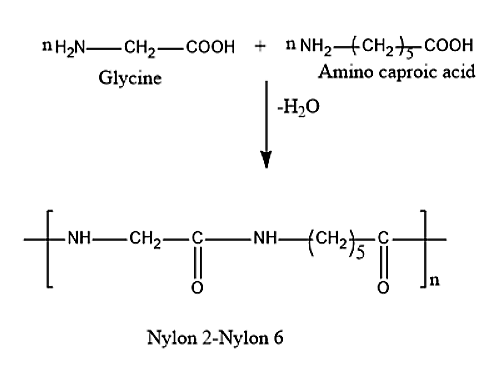
The monomer of Biodegradable polymer, nylon 2-nylon 6 are:
(A) glycine + adipic acid
(B) glycol + phthalic acid
(C) phenol + Urea
(D) glycine + amino caproic acid:
Answer
495.9k+ views
1 likes
Hint: Biodegradable polymer is those polymers which can be broken down into some form of biomass, inorganic salts, water, carbon dioxide and nitrogen by the action of bacteria. Biodegradable polymer is non-toxic, it does not harm us in any way.
Complete answer:
First, what is a biodegradable polymer? When a polymer can be broken down into natural by-products such as carbon dioxide, nitrogen, water, inorganic salt and biomass by bacterial decomposition. Such polymers are called Biodegradable polymers. Some examples of biodegradable polymers are Dextron, PHBV (Polyhydroxy butyrates-co-beta hydroxyvalerate), Nylon 2-nylon 6.
Nylon 2-nylon 6 can be formed by polyamide copolymerization. This reaction takes place between two monomers namely Glycine and amino caproic acid. The formula for glycine is
This a type of condensation reaction in which when n moles of glycine,

The monomers of Biodegradable polymer, nylon 2-nylon 6 are glycine and amino caproic acid.
Therefore, the correct answer is option(D) glycine + amino caproic acid.
Additional information:
The characteristics of biodegradable polymers are given below.
- Biodegradable polymers have good bio-compatibility.
- They are highly nontoxic.
- It is environmentally friendly.
- It is low cost.
- It is capable of controlling the rate of degradation.
Note: Nylon 2-Nylon 6 have various uses such as
- It can be used in the synthesis of Artificial fibers.
- Strings of musical instruments are made using Nylon 2-Nylon 6.
- Bristles of toothbrushes are made from this.
Complete answer:
First, what is a biodegradable polymer? When a polymer can be broken down into natural by-products such as carbon dioxide, nitrogen, water, inorganic salt and biomass by bacterial decomposition. Such polymers are called Biodegradable polymers. Some examples of biodegradable polymers are Dextron, PHBV (Polyhydroxy butyrates-co-beta hydroxyvalerate), Nylon 2-nylon 6.
Nylon 2-nylon 6 can be formed by polyamide copolymerization. This reaction takes place between two monomers namely Glycine and amino caproic acid. The formula for glycine is
This a type of condensation reaction in which when n moles of glycine,

The monomers of Biodegradable polymer, nylon 2-nylon 6 are glycine and amino caproic acid.
Therefore, the correct answer is option(D) glycine + amino caproic acid.
Additional information:
The characteristics of biodegradable polymers are given below.
- Biodegradable polymers have good bio-compatibility.
- They are highly nontoxic.
- It is environmentally friendly.
- It is low cost.
- It is capable of controlling the rate of degradation.
Note: Nylon 2-Nylon 6 have various uses such as
- It can be used in the synthesis of Artificial fibers.
- Strings of musical instruments are made using Nylon 2-Nylon 6.
- Bristles of toothbrushes are made from this.
Latest Vedantu courses for you
Grade 11 Science PCM | CBSE | SCHOOL | English
CBSE (2025-26)
School Full course for CBSE students
₹41,848 per year
Recently Updated Pages
Master Class 12 Economics: Engaging Questions & Answers for Success

Master Class 12 Maths: Engaging Questions & Answers for Success

Master Class 12 English: Engaging Questions & Answers for Success

Master Class 12 Social Science: Engaging Questions & Answers for Success

Master Class 12 Chemistry: Engaging Questions & Answers for Success

Master Class 12 Biology: Engaging Questions & Answers for Success

Trending doubts
Which are the Top 10 Largest Countries of the World?

a Tabulate the differences in the characteristics of class 12 chemistry CBSE

Why is the cell called the structural and functional class 12 biology CBSE

The first general election of Lok Sabha was held in class 12 social science CBSE

Differentiate between homogeneous and heterogeneous class 12 chemistry CBSE

Derive an expression for electric potential at point class 12 physics CBSE




